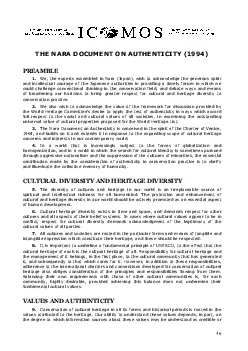

46truthful Knowledge and understanding of these sources of information in relation to original and subsequent characteristics of the cultural he is a requisite basis for assessing all aspects of authe ID: 880780
Download Pdf The PPT/PDF document "PREAMBLE We the experts assembled in Nar..." is the property of its rightful owner. Permission is granted to download and print the materials on this web site for personal, non-commercial use only, and to display it on your personal computer provided you do not modify the materials and that you retain all copyright notices contained in the materials. By downloading content from our website, you accept the terms of this agreement.
1 46 PREAMBLE We, the experts assembled in
46 PREAMBLE We, the experts assembled in Nara (Japan), wish to acknowledge the generous spirit and intellectual courage of the Japanese authorities in providing a timely forum in which we could challenge conventional thinking in the conservation field, and truthful. Knowledge and understanding of these sources of information, in relation to original and subsequent characteristics of the cultural he is a requisite basis for assessing all aspects of authenticity. Authenticity, considered in this way and affirmed in the Charter of Venice, appears as the essential qualifying factor concerning values. The understanding of authenticity plays a fundamental role in all scientific studies of the cultural heritage, in conservation and restoration planning, as well as within the inscription procedures used for the World Heritage Convention and other cultural heritage inventories. All judgements about values attributed to cultural properties as well as the credibility of related information sources may differ from culture to culture, and even within the same culture. It is thus not possible to base judgements of values and authenticity within fixed criteria. On the contrary, the respect due to all cultures requires that heritage properties must be considered and judged within the cultural contexts to which they belong. Therefore, it is of the highest importance and urgency that, within each culture, recognition be accorded to the specific nature of its heritage values and the credibility and truthfulness of related information sources. Depending on the nature of the cultural heritage, its cultural context, and its evolution through time, authenticity judgements may be linked to the worth of a great variety of sources of information. Aspects of the sour
2 ces may include form and design, materia
ces may include form and design, materials and substance, use and function, traditions and techniques, location and setting, and spirit and feeling, and other internal and external factors. The use of these sources permits elaboration of the specific artistic, historictific dimensions of the cultural heritage being APPENDIX 1 Suggestions for follow-up (proposed by H. Stovel) Respect for cultural and heritage diversity requires conscious efforts to avoid imposing mechanistic formulae or standardized procedures in attempting to define or determine authenticity of particular monuments and sites. Efforts to determine authenticity in a manner respectful of cultures and heritage diversity requires approaches which encourage cultures to develop analytical processes and tools specific to their nature and needs. Such approaches may have several aspects in • efforts to ensure assessment of authenticity involve multidisciplinary collaboration ation of all available expertise and knowledge; efforts to ensure attributed values are truly representative of a culture and the diversity of its interests, in particular monuments and sites; efforts to document clearly the particular nature of authenticity for monuments and sites as a practical guide to future treatment and monitoring; efforts to update authenticity assessments in light of changing values and circumstances. Particularly important are efforts to ensure that attributed values are respected, and that their determination includes efforts to build, as far as possible, a multidisciplinary and community consensus concerning these values. Approaches should also build on and facilitate international co-operation among all those with an interest in conservation of cultural heritage, in order to improv
3 e global respect and understanding for t
e global respect and understanding for the diverse expressions and values of each culture. Continuation and extension of this dialogue to the various regions and cultures of the world is a prerequisite to increasing the practical value of consideration of authenticity in the conservation of the common heritage of humankind. Increasing awareness within the public of this fundamental dimension of heritage is an absolute necessity in order to arrive at concrete measures for safeguarding the vestiges of the past. This means developing greater understanding of the values represented by the cultural properties themselves, as well as respecting the role such monuments and sites play in contemporary society. APPENDIX 2 Definitions Conservation: all efforts designed to understand cultural heritage, know its history and meaning, ensure its material safeguard and, as required, itenhancement. (Cultural heritage is understood to include monuments, groups of buildings and sites of cultural value as defined in article one of the World Heritage Convention). Information sources: all material, written, oral and figurative sources which make it possible to know the nature, specifications, meaning and history of the cultural heritage. The Nara Document on Authenticity was drafted by the 45 participants at the Nara Conference on Authenticity in Relation to the World Heritage Convention, held at Nara, Japan, from 1-6 November 1994, at the invitation of the Agency for Cultural Affairs (Government of Japan) and the Nara Prefecture. The Agency organized the Nara Conference in cooperation with UNESCO, ICCROM and ICOMOS. This final version of the Nara Document has been edited by the general rapporteurs of the Nara Conference, Mr. Raymond Lemaire and Mr. Herb Stove